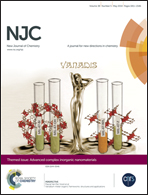A one-pot route to prepare class II hybrid ionogel electrolytes†
Abstract
A new system based on class II hybrid ionogels (Si-IL gels) has been developed for overcoming leaking problems associated with liquid electrolytes in dye-sensitized solar cells (DSSCs). We co-condensed a silica precursor with an alkoxysilane functionalized ionic liquid precursor, under acidic conditions, to obtain a hybrid ionogel where ionic liquid is covalently linked to silica domains. The morphology and the microstructure of the Si-IL xerogels were explored using NMR, SAXS and field emission scanning electron microscopy (FE-SEM). Cyclic voltammetry experiments were carried out to measure the apparent diffusion coefficient of the redox couple I−/I3− into these Si-IL gels. The diffusion coefficient of triiodide in the gel is comparable to the one observed in a solvent-free based ionic liquid electrolyte. These Si-IL gels were evaluated as electrolytes in quasi-solid-state DSSCs. For this purpose, various DSSCs have been fabricated. The cells containing Si-IL ionogels with 50 wt% of a silica modified liquid ionic precursor exhibit a short-circuit photocurrent of 2.8 mA cm−2, an open circuit voltage of 680 mV, a fill factor of 0.65, and an overall efficiency of 1.25%. Accordingly, this work constitutes a proof of concept.

- This article is part of the themed collection: Advanced Complex Inorganic Nanomaterials

 Please wait while we load your content...
Please wait while we load your content...